Inderjit S. Dhillon
LASER: Attention with Exponential Transformation
Nov 05, 2024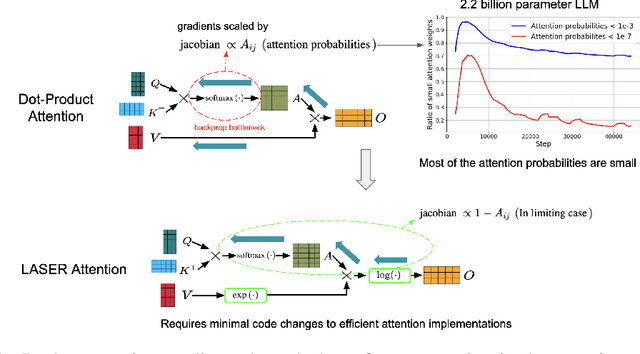


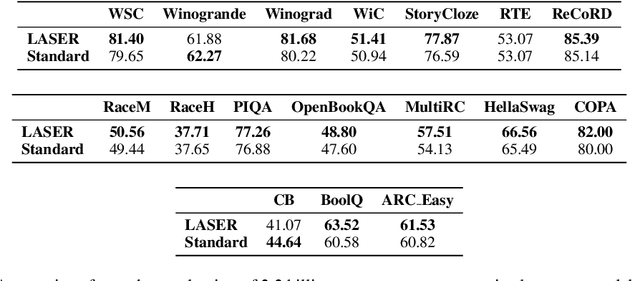
Abstract:Transformers have had tremendous impact for several sequence related tasks, largely due to their ability to retrieve from any part of the sequence via softmax based dot-product attention. This mechanism plays a crucial role in Transformer's performance. We analyze the gradients backpropagated through the softmax operation in the attention mechanism and observe that these gradients can often be small. This poor gradient signal backpropagation can lead to inefficient learning of parameters preceeding the attention operations. To this end, we introduce a new attention mechanism called LASER, which we analytically show to admit a larger gradient signal. We show that LASER Attention can be implemented by making small modifications to existing attention implementations. We conduct experiments on autoregressive large language models (LLMs) with upto 2.2 billion parameters where we show upto 3.38% and an average of ~1% improvement over standard attention on downstream evaluations. Using LASER gives the following relative improvements in generalization performance across a variety of tasks (vision, text and speech): 4.67% accuracy in Vision Transformer (ViT) on Imagenet, 2.25% error rate in Conformer on the Librispeech speech-to-text and 0.93% fraction of incorrect predictions in BERT with 2.2 billion parameters.
LoRA Done RITE: Robust Invariant Transformation Equilibration for LoRA Optimization
Oct 27, 2024Abstract:Low-rank adaption (LoRA) is a widely used parameter-efficient finetuning method for LLM that reduces memory requirements. However, current LoRA optimizers lack transformation invariance, meaning the actual updates to the weights depends on how the two LoRA factors are scaled or rotated. This deficiency leads to inefficient learning and sub-optimal solutions in practice. This paper introduces LoRA-RITE, a novel adaptive matrix preconditioning method for LoRA optimization, which can achieve transformation invariance and remain computationally efficient. We provide theoretical analysis to demonstrate the benefit of our method and conduct experiments on various LLM tasks with different models including Gemma 2B, 7B, and mT5-XXL. The results demonstrate consistent improvements against existing optimizers. For example, replacing Adam with LoRA-RITE during LoRA fine-tuning of Gemma-2B yielded 4.6\% accuracy gain on Super-Natural Instructions and 3.5\% accuracy gain across other four LLM benchmarks (HellaSwag, ArcChallenge, GSM8K, OpenBookQA).
Retraining with Predicted Hard Labels Provably Increases Model Accuracy
Jun 17, 2024Abstract:The performance of a model trained with \textit{noisy labels} is often improved by simply \textit{retraining} the model with its own predicted \textit{hard} labels (i.e., $1$/$0$ labels). Yet, a detailed theoretical characterization of this phenomenon is lacking. In this paper, we theoretically analyze retraining in a linearly separable setting with randomly corrupted labels given to us and prove that retraining can improve the population accuracy obtained by initially training with the given (noisy) labels. To the best of our knowledge, this is the first such theoretical result. Retraining finds application in improving training with label differential privacy (DP) which involves training with noisy labels. We empirically show that retraining selectively on the samples for which the predicted label matches the given label significantly improves label DP training at \textit{no extra privacy cost}; we call this \textit{consensus-based retraining}. For e.g., when training ResNet-18 on CIFAR-100 with $\epsilon=3$ label DP, we obtain $6.4\%$ improvement in accuracy with consensus-based retraining.
Towards Quantifying the Preconditioning Effect of Adam
Feb 11, 2024Abstract:There is a notable dearth of results characterizing the preconditioning effect of Adam and showing how it may alleviate the curse of ill-conditioning -- an issue plaguing gradient descent (GD). In this work, we perform a detailed analysis of Adam's preconditioning effect for quadratic functions and quantify to what extent Adam can mitigate the dependence on the condition number of the Hessian. Our key finding is that Adam can suffer less from the condition number but at the expense of suffering a dimension-dependent quantity. Specifically, for a $d$-dimensional quadratic with a diagonal Hessian having condition number $\kappa$, we show that the effective condition number-like quantity controlling the iteration complexity of Adam without momentum is $\mathcal{O}(\min(d, \kappa))$. For a diagonally dominant Hessian, we obtain a bound of $\mathcal{O}(\min(d \sqrt{d \kappa}, \kappa))$ for the corresponding quantity. Thus, when $d < \mathcal{O}(\kappa^p)$ where $p = 1$ for a diagonal Hessian and $p = 1/3$ for a diagonally dominant Hessian, Adam can outperform GD (which has an $\mathcal{O}(\kappa)$ dependence). On the negative side, our results suggest that Adam can be worse than GD for a sufficiently non-diagonal Hessian even if $d \ll \mathcal{O}(\kappa^{1/3})$; we corroborate this with empirical evidence. Finally, we extend our analysis to functions satisfying per-coordinate Lipschitz smoothness and a modified version of the Polyak-\L ojasiewicz condition.
Automatic Engineering of Long Prompts
Nov 16, 2023Abstract:Large language models (LLMs) have demonstrated remarkable capabilities in solving complex open-domain tasks, guided by comprehensive instructions and demonstrations provided in the form of prompts. However, these prompts can be lengthy, often comprising hundreds of lines and thousands of tokens, and their design often requires considerable human effort. Recent research has explored automatic prompt engineering for short prompts, typically consisting of one or a few sentences. However, the automatic design of long prompts remains a challenging problem due to its immense search space. In this paper, we investigate the performance of greedy algorithms and genetic algorithms for automatic long prompt engineering. We demonstrate that a simple greedy approach with beam search outperforms other methods in terms of search efficiency. Moreover, we introduce two novel techniques that utilize search history to enhance the effectiveness of LLM-based mutation in our search algorithm. Our results show that the proposed automatic long prompt engineering algorithm achieves an average of 9.2% accuracy gain on eight tasks in Big Bench Hard, highlighting the significance of automating prompt designs to fully harness the capabilities of LLMs.
FINGER: Fast Inference for Graph-based Approximate Nearest Neighbor Search
Jun 22, 2022

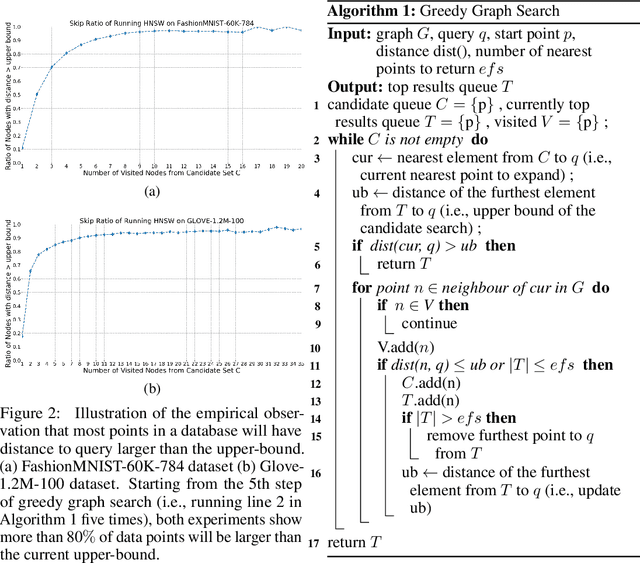
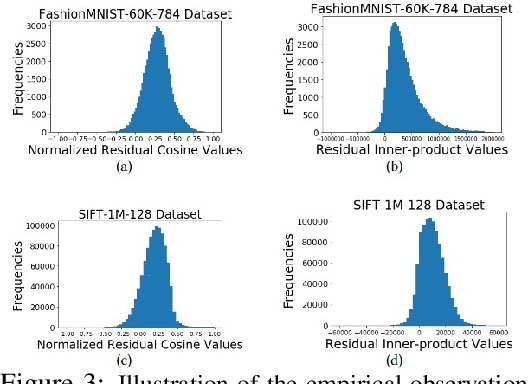
Abstract:Approximate K-Nearest Neighbor Search (AKNNS) has now become ubiquitous in modern applications, for example, as a fast search procedure with two tower deep learning models. Graph-based methods for AKNNS in particular have received great attention due to their superior performance. These methods rely on greedy graph search to traverse the data points as embedding vectors in a database. Under this greedy search scheme, we make a key observation: many distance computations do not influence search updates so these computations can be approximated without hurting performance. As a result, we propose FINGER, a fast inference method to achieve efficient graph search. FINGER approximates the distance function by estimating angles between neighboring residual vectors with low-rank bases and distribution matching. The approximated distance can be used to bypass unnecessary computations, which leads to faster searches. Empirically, accelerating a popular graph-based method named HNSW by FINGER is shown to outperform existing graph-based methods by 20%-60% across different benchmark datasets.
Counterfactual Learning To Rank for Utility-Maximizing Query Autocompletion
Apr 22, 2022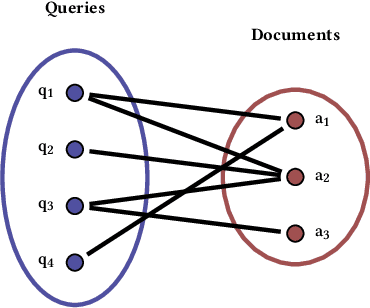

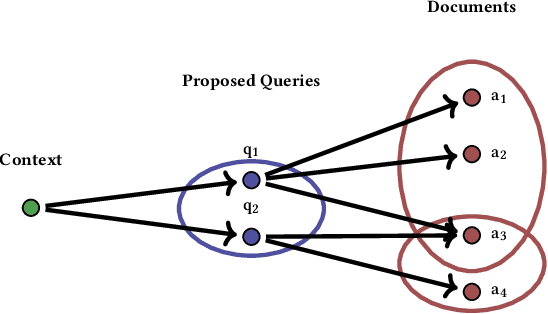
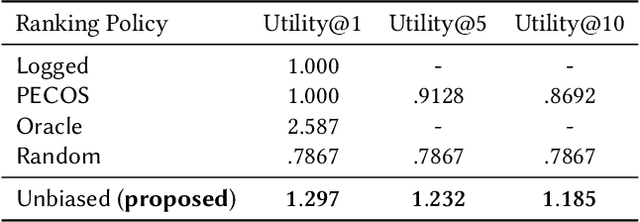
Abstract:Conventional methods for query autocompletion aim to predict which completed query a user will select from a list. A shortcoming of this approach is that users often do not know which query will provide the best retrieval performance on the current information retrieval system, meaning that any query autocompletion methods trained to mimic user behavior can lead to suboptimal query suggestions. To overcome this limitation, we propose a new approach that explicitly optimizes the query suggestions for downstream retrieval performance. We formulate this as a problem of ranking a set of rankings, where each query suggestion is represented by the downstream item ranking it produces. We then present a learning method that ranks query suggestions by the quality of their item rankings. The algorithm is based on a counterfactual learning approach that is able to leverage feedback on the items (e.g., clicks, purchases) to evaluate query suggestions through an unbiased estimator, thus avoiding the assumption that users write or select optimal queries. We establish theoretical support for the proposed approach and provide learning-theoretic guarantees. We also present empirical results on publicly available datasets, and demonstrate real-world applicability using data from an online shopping store.
Sample Efficiency of Data Augmentation Consistency Regularization
Feb 24, 2022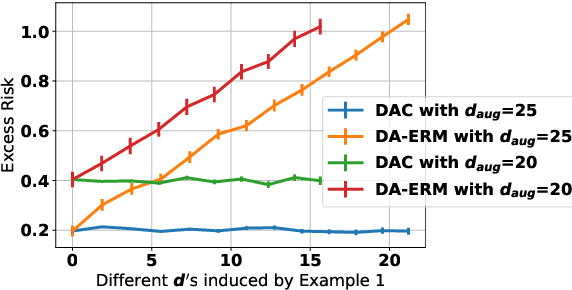

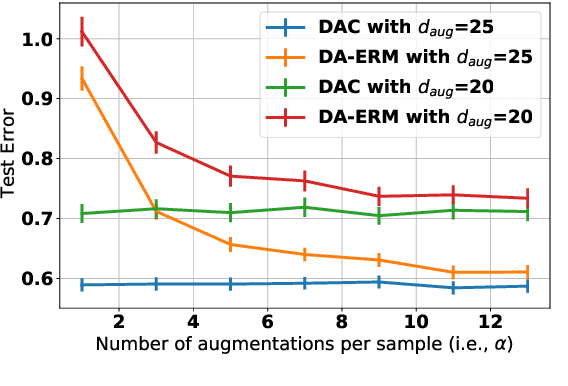

Abstract:Data augmentation is popular in the training of large neural networks; currently, however, there is no clear theoretical comparison between different algorithmic choices on how to use augmented data. In this paper, we take a step in this direction - we first present a simple and novel analysis for linear regression, demonstrating that data augmentation consistency (DAC) is intrinsically more efficient than empirical risk minimization on augmented data (DA-ERM). We then propose a new theoretical framework for analyzing DAC, which reframes DAC as a way to reduce function class complexity. The new framework characterizes the sample efficiency of DAC for various non-linear models (e.g., neural networks). Further, we perform experiments that make a clean and apples-to-apples comparison (i.e., with no extra modeling or data tweaks) between ERM and consistency regularization using CIFAR-100 and WideResNet; these together demonstrate the superior efficacy of DAC.
Cluster-and-Conquer: A Framework For Time-Series Forecasting
Oct 26, 2021
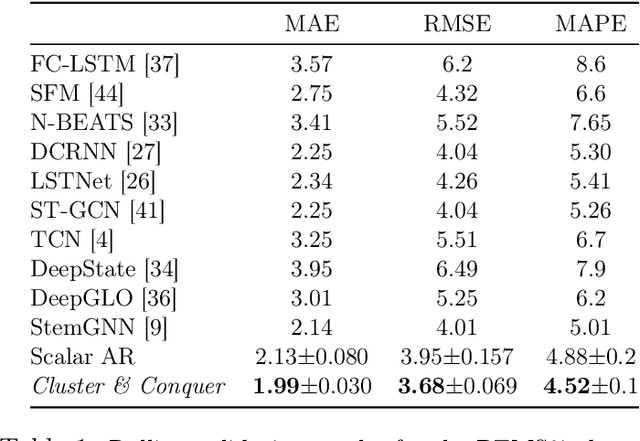
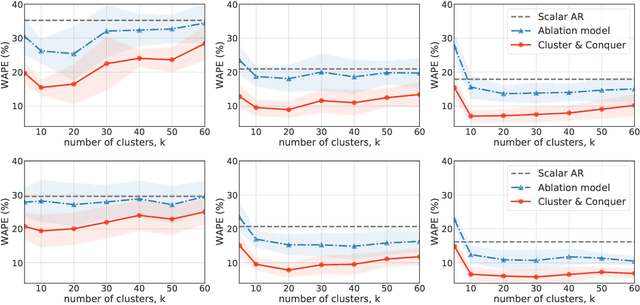
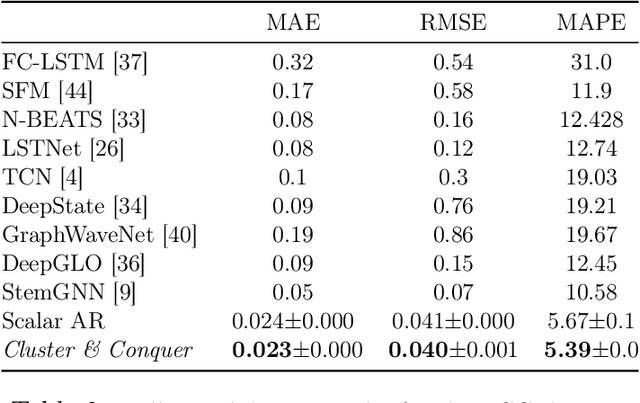
Abstract:We propose a three-stage framework for forecasting high-dimensional time-series data. Our method first estimates parameters for each univariate time series. Next, we use these parameters to cluster the time series. These clusters can be viewed as multivariate time series, for which we then compute parameters. The forecasted values of a single time series can depend on the history of other time series in the same cluster, accounting for intra-cluster similarity while minimizing potential noise in predictions by ignoring inter-cluster effects. Our framework -- which we refer to as "cluster-and-conquer" -- is highly general, allowing for any time-series forecasting and clustering method to be used in each step. It is computationally efficient and embarrassingly parallel. We motivate our framework with a theoretical analysis in an idealized mixed linear regression setting, where we provide guarantees on the quality of the estimates. We accompany these guarantees with experimental results that demonstrate the advantages of our framework: when instantiated with simple linear autoregressive models, we are able to achieve state-of-the-art results on several benchmark datasets, sometimes outperforming deep-learning-based approaches.
Fast Multi-Resolution Transformer Fine-tuning for Extreme Multi-label Text Classification
Oct 01, 2021

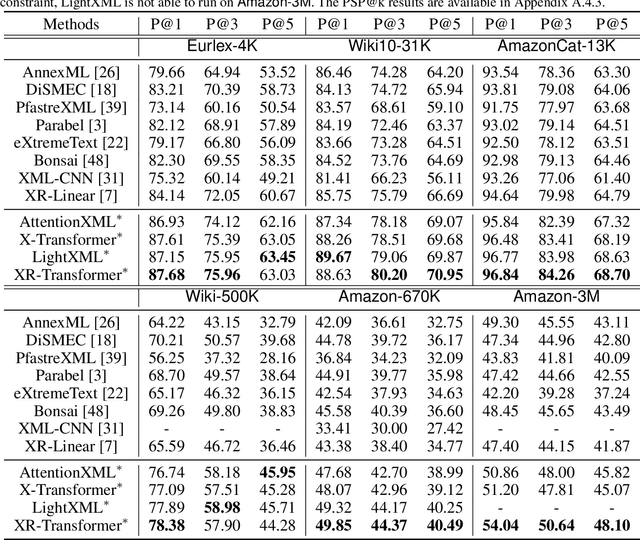

Abstract:Extreme multi-label text classification (XMC) seeks to find relevant labels from an extreme large label collection for a given text input. Many real-world applications can be formulated as XMC problems, such as recommendation systems, document tagging and semantic search. Recently, transformer based XMC methods, such as X-Transformer and LightXML, have shown significant improvement over other XMC methods. Despite leveraging pre-trained transformer models for text representation, the fine-tuning procedure of transformer models on large label space still has lengthy computational time even with powerful GPUs. In this paper, we propose a novel recursive approach, XR-Transformer to accelerate the procedure through recursively fine-tuning transformer models on a series of multi-resolution objectives related to the original XMC objective function. Empirical results show that XR-Transformer takes significantly less training time compared to other transformer-based XMC models while yielding better state-of-the-art results. In particular, on the public Amazon-3M dataset with 3 million labels, XR-Transformer is not only 20x faster than X-Transformer but also improves the Precision@1 from 51% to 54%.
 Add to Chrome
Add to Chrome Add to Firefox
Add to Firefox Add to Edge
Add to Edge